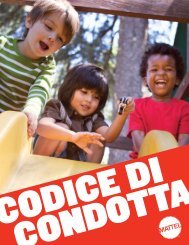2009 Global Citizenship Report - Mattel
2009 Global Citizenship Report - Mattel
2009 Global Citizenship Report - Mattel
Create successful ePaper yourself
Turn your PDF publications into a flip-book with our unique Google optimized e-Paper software.
OUR PRODUCT INTEGRITY PROCESS<br />
At each stage of the development process our<br />
<strong>Global</strong> Product Integrity team is engaged to ensure<br />
that products meet or exceed our standards and<br />
specifications. We have added new requirements to<br />
our processes and dedicated more resources to<br />
improve product quality and safety. More than<br />
1,500 employees worldwide are dedicated to the<br />
quality, safety and overall integrity of our products,<br />
including engineers, technicians and auditors.<br />
Our Product Integrity Process includes the<br />
following steps:<br />
1. Review Design Concept: New product<br />
concepts are reviewed for quality and safety<br />
issues. Concepts are refined as needed.<br />
2. Generate Specification: Quality and safety<br />
requirements are updated and communicated<br />
to the Design team and Product Integrity<br />
group at each manufacturing location.<br />
3. Develop and Refine Prototype: Prototypes of<br />
new products are evaluated, and quality and<br />
safety specifications are updated as necessary.<br />
4. Qualify Design: Final testing of prototypes is<br />
done to ensure quality and safety specifications<br />
are met.<br />
5. Qualify Process: First production runs are<br />
closely monitored to ensure the product can<br />
be consistently produced.<br />
6. Spot Audits: Ongoing spot audits are conducted<br />
at critical points throughout the production<br />
cycle—from the point when materials or<br />
component parts are received to the inspection<br />
of finished goods, ensuring overall production<br />
has met our requirements.<br />
7. Review Consumer Feedback: Consumer<br />
feedback is monitored and analyzed to identify<br />
any potential issues and determine the root<br />
cause. Manufacturing processes are modified<br />
as appropriate.<br />
8. Update Procedures: Based on regulatory<br />
developments and consumer feedback, internal<br />
standards and specifications are refined as<br />
needed to ensure quality of production.<br />
MANUFACTURING<br />
IMPROVING OUR QUALITY SYSTEMS<br />
We strive to sustain our consumers’ trust by employing<br />
strict standards that extend from product design to<br />
manufacturing and distribution. In 2008, we brought<br />
together our most experienced quality experts to review<br />
existing standards and began development of an<br />
enhanced Quality Management System (QMS) that will<br />
standardize the product integrity process in our<br />
owned/operated, as well as our vendor facilities. We<br />
designed the QMS to build upon the International<br />
Organization for Standardization (ISO) 9000 system. An<br />
external quality systems consultant validated our QMS<br />
and <strong>Mattel</strong> also sought to benchmark our practices and<br />
learn from others with leading quality controls systems.<br />
TAKING AN INTEGRATED APPROACH<br />
As we reviewed existing standards, we saw an opportunity<br />
to integrate the various requirements contained<br />
in our product quality and safety procedures with our<br />
<strong>Global</strong> Manufacturing Principles (GMP), and combined<br />
them into one comprehensive system. The new system<br />
will streamline our processes, allowing us to audit our<br />
owned/operated and vendor factories against our standards<br />
for quality and safety at the same time we monitor<br />
for social and environmental compliance. Implementation<br />
of our QMS is underway at our owned/operated and<br />
vendor factories. New vendors will also be evaluated<br />
against the QMS standards.<br />
In addition to our internal efforts, the Toy Safety<br />
Certification Program (TSCP) is being developed in the<br />
U.S. by the Toy Industry Association (TIA) and the<br />
American National Standards Institute (ANSI). The goal<br />
of the TSCP is to create a sustainable system to certify<br />
that toys sold in the U.S. market meet the requirements<br />
of the 2008 Consumer Product Safety Improvement Act,<br />
as well as any other relevant U.S. regulations and standards<br />
that apply to children’s products. Representatives<br />
from <strong>Mattel</strong>’s Product Integrity organization served on<br />
the working groups that helped develop the program.<br />
“<br />
When Vodafone wanted to benchmark its product quality<br />
programs we approached <strong>Mattel</strong>. Their willingness to openly<br />
discuss their processes and improvements benefited Vodafone’s<br />
team. Leading companies that support and challenge each other<br />
to continuously improve are the ones that will drive real<br />
progress forward.<br />
John Daly<br />
Head of <strong>Global</strong> Health, Safety & Wellbeing<br />
Vodafone Group Services<br />
The proposed program is designed to certify that a toy:<br />
1. Meets safety requirements for toy design as attested<br />
to by a qualified safety professional<br />
2. Has test reports validating that the toy meets U.S.<br />
safety standards<br />
3. Is manufactured in a factory with ISO-9000<br />
certification specifically for toy manufacturing or<br />
is subject to more frequent testing<br />
<strong>Mattel</strong> supports the development of such an industry-wide<br />
initiative and has committed the expertise of several of<br />
our product integrity executives to participate in the<br />
multi-stakeholder dialogue that has produced the<br />
program’s core features. The process has included a broad<br />
range of skills and perspectives from representatives of<br />
the toy industry, NGOs and professional standard-setting<br />
groups. We are hopeful that the final TSCP program will<br />
be a useful platform for managing compliance with the<br />
new regulatory requirements, as well as existing<br />
U.S. requirements.<br />
CAREFULLY SELECTING MATERIALS FOR USE IN TOYS<br />
At <strong>Mattel</strong>, the integrity, safety and quality of our toys are<br />
a fundamental part of our commitment to parents who<br />
have placed their trust in us for decades —and we continue<br />
to earn their trust every day.<br />
Our toys are designed to meet or exceed applicable safety<br />
standards wherever they are sold.<br />
Materials in a toy must serve a variety of purposes—such<br />
as to make plastic soft and pliable to prevent it from<br />
14 | OUR TOYS 15 | GLOBAL CITIZENSHIP REPORT<br />
”<br />
becoming brittle over time and breaking into sharp<br />
edges, or to make plastic hard and durable under stress.<br />
As part of our safety processes, we continually evaluate<br />
and carefully select materials and components to create<br />
engaging toys that are durable and safe, all while working<br />
to comply with each country’s unique regulations.<br />
In some cases, consumers have raised questions about<br />
specific materials, such as Bisphenol-A (BPA), which is<br />
typically found in polycarbonate plastic, an expensive<br />
material that is mainly utilized for its shatterproof<br />
properties in specific safety-related applications, such as<br />
bike helmets and eye glasses. <strong>Mattel</strong> uses polycarbonate<br />
sparingly in a few specific toy lines and only when<br />
utilizing a substitute material would compromise the<br />
safety or quality requirements of the product. Recent<br />
focus of the debate surrounding BPA has been its use in<br />
food contact items, not products where it serves in a<br />
safety capacity. To address this concern, in January <strong>2009</strong><br />
we updated our requirements, and notified our licensees<br />
to use non BPA-containing materials in food storage and<br />
food contact products, such as infant feeding items, plates<br />
and cups.<br />
Polyvinylchloride, or PVC, is used primarily to make<br />
construction materials and packaging. The toy industry<br />
is a small user of PVC compared to other industries like<br />
the construction and automotive manufacturing industries.<br />
The use of PVC in consumer products has been<br />
deemed safe for more than 50 years by the U.S. Consumer<br />
Products Safety Commission (CPSC), Health Canada and<br />
their counterparts in Europe, and we continue to use<br />
PVC in our products and packaging.






